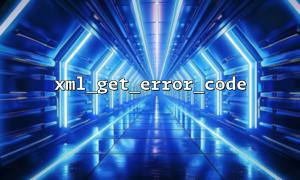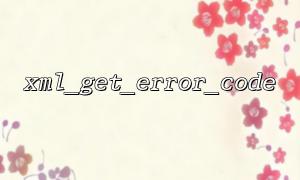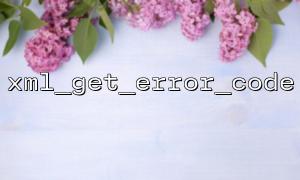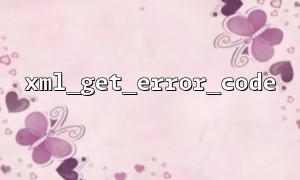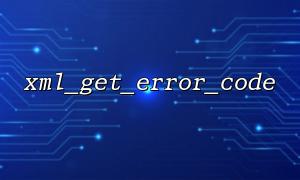When working with XML in PHP, error management is a critical aspect. PHP offers several functions related to XML errors, with xml_get_error_code() and libxml_clear_errors() being particularly important for debugging and handling XML parsing issues. Understanding and using them together correctly can help prevent the error stack from becoming polluted, improving the robustness and maintainability of your code.
PHP uses the libxml library to parse XML, which maintains an internal error stack to collect error information. Each time a parsing operation encounters an error, it's added to this stack. If the stack isn't cleared in time, leftover errors can affect subsequent parsing attempts, leading to confusion and inaccurate error handling.
This is why libxml_clear_errors() is a crucial function—it clears the current error stack, ensuring that the next parsing operation starts with a "clean slate."
It's important to distinguish between them: xml_get_error_code() applies to the older XML extension (i.e., when using xml_parser_create()), whereas libxml_get_errors() and libxml_clear_errors() belong to the libxml extension, primarily used with DOMDocument and simplexml.
They should not be used interchangeably, but understanding their mechanisms helps you choose the right function in different contexts.
The example below shows how to use libxml_clear_errors() to clear errors triggered by DOMDocument, while demonstrating graceful error handling.
libxml_use_internal_errors(true);
$doc = new DOMDocument();
$doc->loadXML('<root><invalid></root>'); // Error: unclosed tag
$errors = libxml_get_errors();
foreach ($errors as $error) {
echo displayXmlError($error), "\n";
}
// Clear the error stack
libxml_clear_errors();
The helper function displayXmlError() provides a formatted error output:
function displayXmlError($error)
{
switch ($error->level) {
case LIBXML_ERR_WARNING:
$return = "Warning {$error->code}: ";
break;
case LIBXML_ERR_ERROR:
$return = "Error {$error->code}: ";
break;
case LIBXML_ERR_FATAL:
$return = "Fatal Error {$error->code}: ";
break;
}
$return .= trim($error->message);
$return .= " Line: {$error->line}, Column: {$error->column}";
return $return;
}
Here, we enabled libxml_use_internal_errors(true) to catch errors instead of printing them directly to the browser. Then we retrieve all errors using libxml_get_errors(), process them manually, and finally clear the stack with libxml_clear_errors() to avoid interference with future XML operations.
If you're using the older, event-driven XML parser:
$parser = xml_parser_create();
if (!xml_parse($parser, '<root><invalid></root>')) {
$errorCode = xml_get_error_code($parser);
$errorString = xml_error_string($errorCode);
echo "XML Error: {$errorString}";
}
xml_parser_free($parser);
In this context, xml_get_error_code() is used to fetch the most recent error code. However, since this method doesn't accumulate multiple errors, there's no need to use libxml_clear_errors().
Choose the right parser: Prefer using DOMDocument or SimpleXML along with libxml_* functions for more powerful and manageable XML handling.
Always clear after handling: After calling libxml_get_errors(), make sure to call libxml_clear_errors() to reset the error stack.
Encapsulate error handling logic: Wrap your parsing and error-handling logic into functions to enhance reusability and keep your code clean.
Test and debug carefully: Enable detailed error output in the development environment and suppress it in production—logging errors instead.
Regardless of the XML processing method you use, understanding and clearing the error stack is key to ensuring application stability. libxml_clear_errors() helps prevent leftover errors from affecting future operations, while xml_get_error_code() is useful for quickly pinpointing issues in older parsers. Using both appropriately allows you to build more robust and maintainable XML processing logic.
For more XML handling practices and error management strategies, visit: https://gitbox.net/articles/php-xml-error-handling
